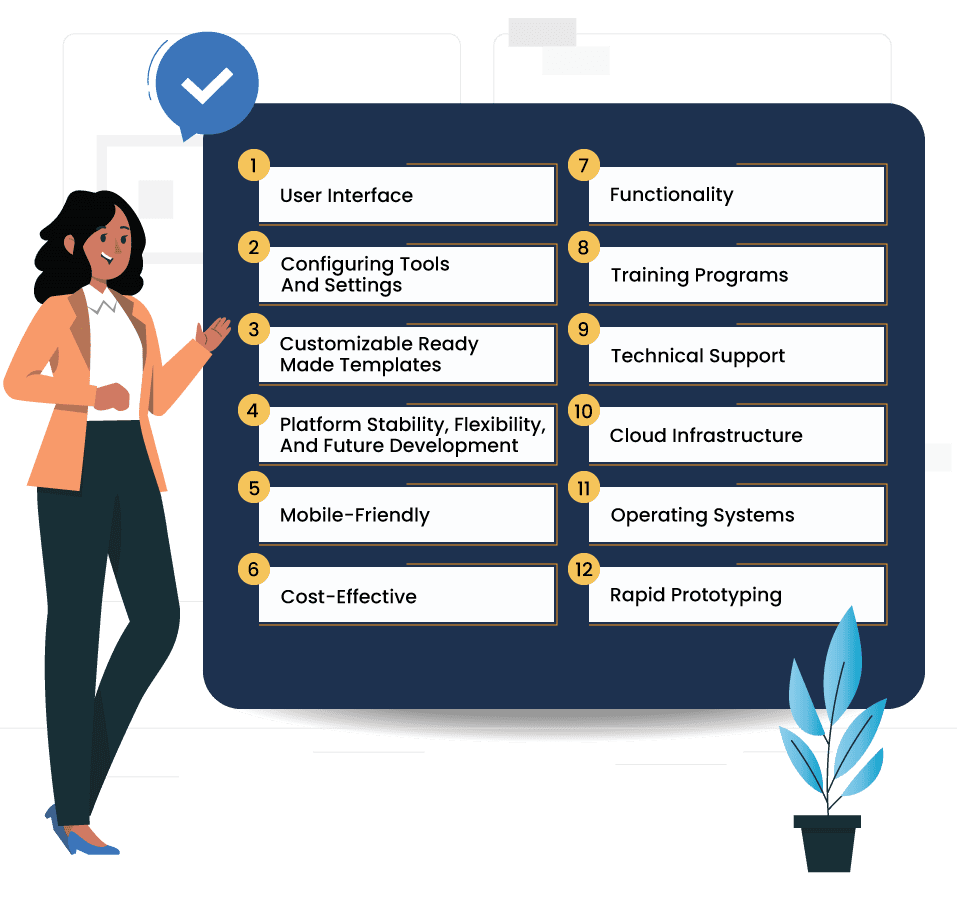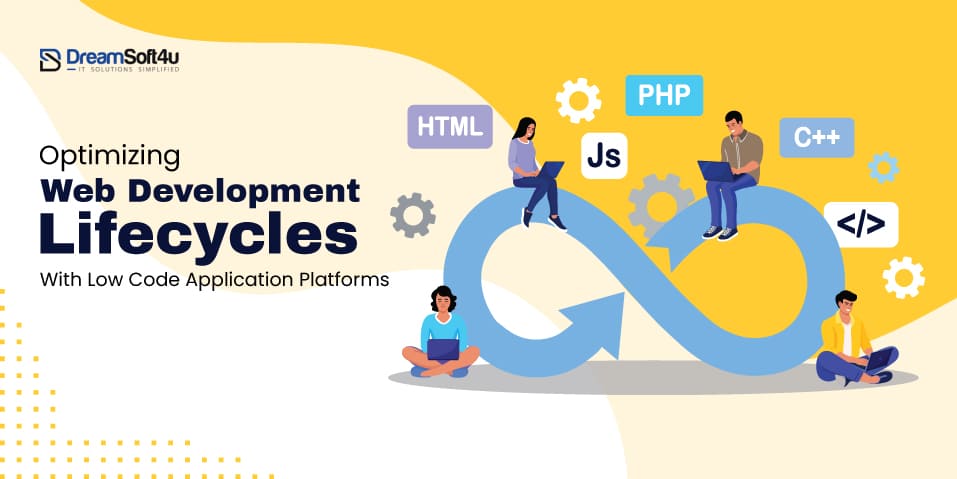Low-code development is designing software development systems that reduce programming code to the bare minimum. Web development lifecycles with Low code development deliver software solutions faster, at lower costs, and with more flexibility and less risk of errors.
As an application development methodology, software engineers can design software systems without writing code, instead relying on pre-designed templates and APIs to build apps. It has recently gained popularity due to its advantages over traditional programming languages like Java or C++.
It has recently gained popularity due to its advantages over traditional programming languages like Java or C++. This blog post will cover low code development and how to use it for your web applications today. So, let’s start!
Table of Contents
ToggleWhat is Low Code Solutions in software development?
Low code development employs tools and processes that allow software systems to facilitate Web Development Lifecycles without writing a single line of coding code.
This enables software engineers to rely on pre-coded templates and APIs, or “low code solutions,” that provide a rapid response time for developing applications.
Let’s Discuss Your Project
Get a free consultation and let us know your project idea to turn it into an excellent digital product
98+ Client Retention
What is Low-Code Web Development Lifecycle?
Low-code web development lifecycle is a process that helps you create, deploy, and manage web applications using low-code languages and platforms.
With low-code web development lifecycles, it’s easier to create prototypes and test iterations of your web applications quickly.
You can easily share and collaborate on web application projects with team members with tools like GitHub.
The process helps you efficiently manage updates to your web applications with versioning tools. It saves time by reducing the need for manual deployment processes.
Low-code web development lifecycle helps you quickly deploy your web applications to various platforms and devices. This process usually involves using automation software such as Jenkins and Jenkins X Preview.
Creating, testing, deploying, and managing web applications using low-code languages has made development more efficient and cost-effective for organizations of all sizes.
You May Also Like:
What is Low Code Automation?
Low-code automation software streamlines the process of automating tasks and actions in low-code development. This software helps you automate testing, deployment, versioning, and user management tasks. It also makes it easy to connect with different systems and applications for data analysis.
Built-in API and API development
Low code automation platforms offer built-in APIs that allow the API development team to access specific functionality without writing any code. This significantly reduces development costs and makes it easier to adapt system functionality over time.
Custom Integrations
Low code automation is a software development process that uses less code to achieve the same results as code written in a higher-code language.
Low code automation platforms allow developers to automate everyday tasks using simple commands, resulting in faster and more efficient development workflows.
Benefits of Low Code Application Platforms (LCAP)

These are some of the benefits Low Code Application Platforms offer:
App Development in Collaboration
The main benefits of Low code application platforms (LCAPs) are that they make it easy for the app development teams to develop web applications in collaboration. In addition, LCAPs provide a platform for code sharing, version control, and automatic testing, which makes it easy for teams to work on the same project without constantly checking in and out of code.
Enhances Agility
Low code application platforms (LCAPs) help businesses improve their agility by reducing the time it takes to develop a new web application.
These software development kits (SDKs) allow for quick iteration and the ability to quickly change and test the application. This allows businesses to respond more quickly to changes in customer behavior or market conditions.
Accelerating Development Cycles
Low code application platforms (LCAPs) can help accelerate development cycles by automating everyday tasks. When using LCAPs, developers do not need to code or edit applications manually; this can save time and energy. Additionally, LCP can help improve quality and consistency across multiple projects.
Reduced Cost
Low-code application platforms, such as LCAPs, can offer a cost-effective solution for developing web applications. LCAPs do not require any upfront investment compared to traditional web development frameworks. This means that you can start using LCAPs without worrying about the financial burden of software development.
Multi-experience is a Powerful Tool
Multi-experience is a powerful tool that can help you optimize your web development lifecycles. Low-code application platforms make it easy to develop, test, and deploy applications using multiple technologies simultaneously. This allows you to quickly adopt new technologies and improve software quality without rewriting existing code.
You May Also Like:
Limitations and How to Overcome Them
Despite their advantages, LCAPs have a few limitations. They can be challenging for experienced developers and may only work with some programming languages. Additionally, development teams must be willing to adopt specific software development approaches to take advantage of LCAPs.
You might get backed into a corner.
Development teams should use LCAPs and other software development tools to overcome these limitations. For example, they can use GitHub and Travis CI to deploy applications and monitor code quality continuously.
Additionally, they should focus on automating repetitive tasks and building a modular codebase so that changes are easy to make.
Ultimately, using a low-code application platform will require hard work but can significantly benefit agile software development cycles and cost savings.
Debugging Low-Code Applications is Hard
Debugging low-code applications can be difficult. In particular, it can be challenging to track down and fix software development errors in code that is written using LCAPs.
Debugging tools such as source control systems (GitHub or Travis CI) and error tracking systems (JIRA or Asana) is essential for helping developers find and correct bugs quickly. Additionally, they should use developer best practices when coding to make debugging easier.
Low-code platforms are frequently referred to as “resume killers” by developers.
Some developers may feel that using low-code platforms will hurt their resumes.
However, experience has shown that these platforms can be a powerful tools for software development teams.
In addition, only a few jobs require extensive programming skills. By using LCAPs and other tools, developers can still benefit from learning and mastering this technology.
How to Choose a Low-Code Integration Platform?
When choosing a low-code integration platform, it is essential to consider the specific needs of your business. Factors that you may want to consider include:

User Interface
The user interface of a low-code development platform should be intuitive and easy to use. A well-designed user interface will help you quickly develop software applications without learning complex programming languages.
Quick start guides, chatbots, and tutorials are also essential, as they can teach you how to use the user interface and build software applications using LCAPs.
Configuring Tools and Settings
Configuring tools and settings is also essential when using a low-code development platform. For instance, you may need to configure project managers, source control systems, development environment software, etc.
Configuring tools and settings may be fine if you have extensive experience with specific development frameworks or programming languages.
Customizable Ready-Made Templates
Another benefit of using a low-code development platform is that you can easily customize ready-made templates. This allows you to quickly develop software applications with the same look and feel across different platforms and devices.
Furthermore, customizing templates makes migrating software applications from one development platform to another easy.
Platform Stability, Flexibility, and Future Development
A key consideration when choosing a low-code development platform is stability, flexibility, and future development. The best platforms are reliable and easy to use. They also provide ample opportunities for customization so that your software applications remain unique.
Mobile-Friendly
Many low-code development platforms are also mobile-friendly. As a result, you can quickly develop software applications for devices like smartphones and tablets.
You May Also Like:
Cost-Effective
Low-code development platforms are also cost-effective. This means that you can develop software applications with minimal upfront costs. Some of the best low-code development platforms include Appcelerator, CodeNow, Codefresh, and Jolt.
Functionality
Some of the best low-code development platforms provide a wide range of functionality, including project management, source control, development environment software, and more. This makes them suitable for different types of software applications.
Training Programs
In addition to the benefits listed above, many low-code development platforms come with comprehensive training programs. This lets you quickly learn how to use the platform and develop software applications.
Technical Support
Most low-code development platforms come with comprehensive technical support. This ensures you can get help and use the platform to its full potential.
Cloud Infrastructure
Cloud-based software development platforms provide the potential to significantly speed up by allowing you to work on projects from anywhere in the world.
Need help in optimizing web development lifecycles?
Check out DreamSoft4u right now!
98+ Client Retention
Operating Systems
Many low-code development platforms are also available for different operating systems. This means you can use them to develop software applications on various devices, including computers and mobile devices.
Rapid Prototyping
Some low-code development platforms include rapid prototyping tools. This lets you quickly create software applications in a mock-up format.
Conclusion
A well-designed user interface is essential when using low-code development platforms. Quick start guides and tutorials can teach you how to use the user interface and build software applications using LCAPs.
Configuring tools and settings are also necessary, as they may need to be configured differently depending on the development platform used.
The best low-code development platforms are stable, flexible, mobile-friendly, and offer ample opportunities for customization.
With the explosion of software development platforms on the market, it can take time to determine which platform is best for your specific needs.
However, by reviewing features and comparing different platforms, you should be able to select a low-code development platform that is perfect for your project requirements.
Do you need clarification? Check out DreamSoft4u to connect with our web development team.










